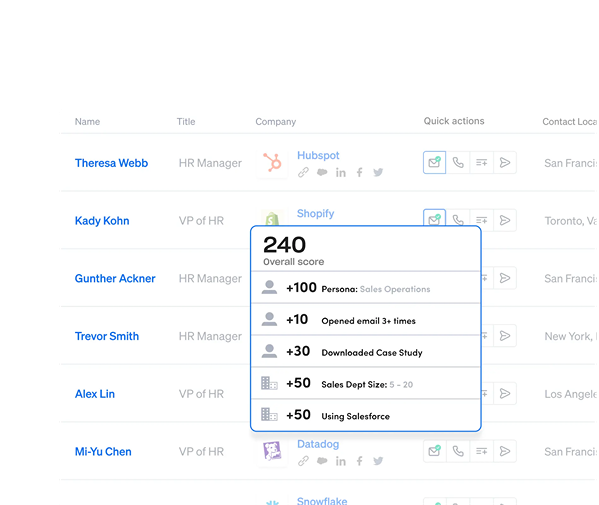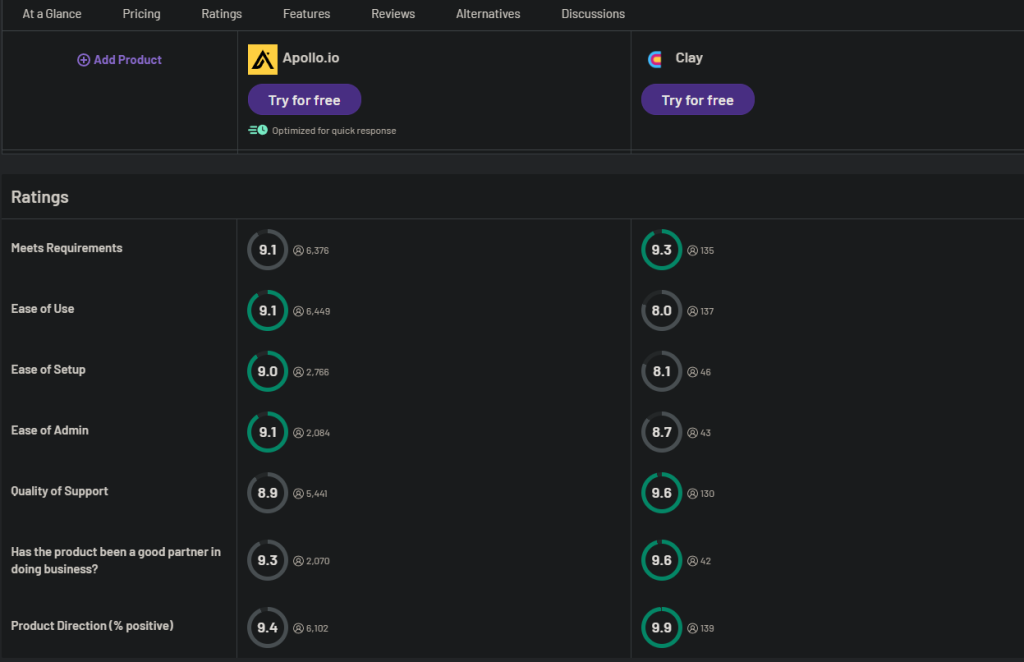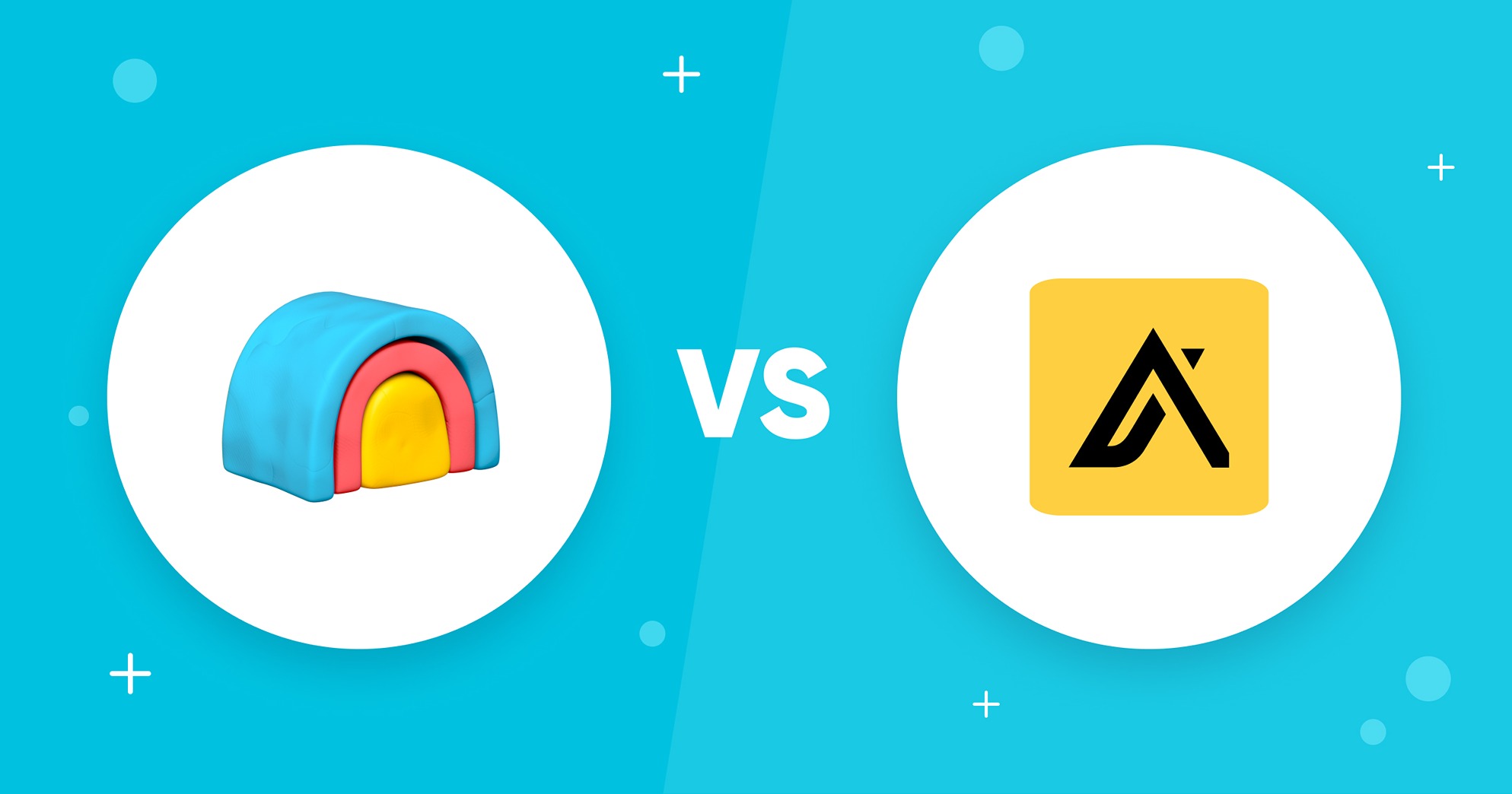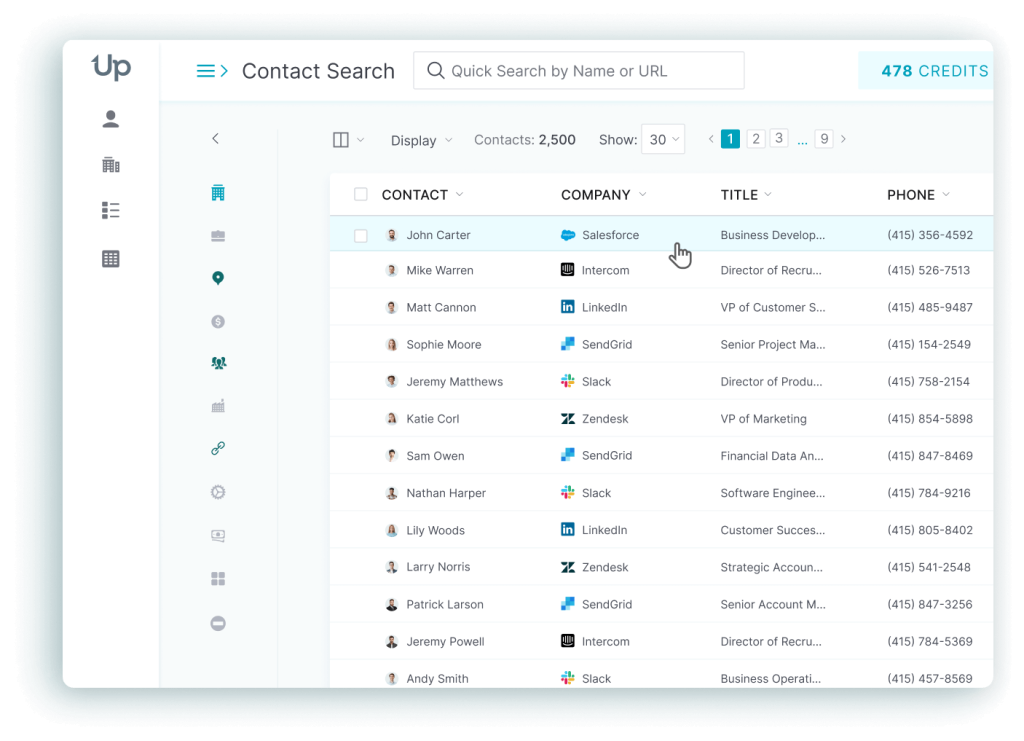Knowledge is power, and that is doubly true in the world of sales intelligence.
The more information you have about your prospective clients, the better equipped you are to craft targeted, meaningful outreach and grow your business.
Two popular sales intelligence platforms in the industry are, of course, Clay and Apollo.io. Each offers their own unique features, but you’ll find that there’s some overlap between the two as well. To best decide which one is the best fit for your sales team, we need to dive into these features, the integrations of both platforms, and their overall functionality.
Let’s examine the differences in more detail in this deep dive into Clay and Apollo.io.
What is Clay?

Clay is a sales intelligence tool that streamlines the often laborious process of lead generation. It automatically generates leads by aggregating data from various sources, creating detailed profiles of prospective leads for your sales staff to consider.
This profile includes emails, phone numbers, and social media profiles. The platform uses AI to optimize outreach strategies to save time and allow teams to focus on the human side of sales rather than getting bogged down in lead gen.
With a valuation of $500 million, the company raised $46 million in Series B funding in July 2024 and is partnered with Sequoia Capital, a strong vote of confidence from the venture capital industry.
What is Apollo?

Apollo.io is a sales engagement and lead generation platform that enables teams to identify, contact, and engage prospective clients. It includes features like email outreach, CRM integrations, and real-time data updates, as well as analytics and tracking of platform activities.
Apollo.io scans through a vast collection of databases of potential B2B leads, including websites like LinkedIn, to gather verified phone numbers and emails.
The company was founded in 2015 and is valued at $1.5 billion, most recently receiving $100 million in a round of Series D funding in August 2023.
What is the Difference Between Clay and Apollo?
These features include email sequencing, performance tracking, and CRM synchronization, and we’ll be exploring the features of both platforms in more detail in the sections below.
A major difference between the two platforms is that Clay’s smaller database allows for more accuracy but fewer potential leads. On the other hand, Apollo.io’s data accuracy can sometimes be inconsistent but offers access to more data and more potential leads.
Apollo.io is an all-in-one sales and engagement platform, offering a wider suite of tools with a proprietary database of over 275 million contacts and 73 million companies.
By comparison, Clay is a specific tool aimed with, compared to Apollo.io, a more precise and limited set of functions. Clay does not have a proprietary database of contacts and companies but integrates other data enrichment sources, including Apollo.io.
Due to the differences in costs for initial users, Clay may be more suited to smaller companies while large businesses may tend to favor Apollo.io, but this depends heavily on the needs and goals of each individual sales team.
Let’s look at the features of each platform side by side to get a better sense of which tool might be best for your sales team.
Clay vs. Apollo At a Glance
| Clay | Apollo | |
| Use Cases | Lead generation, data enrichment, outreach | Lead generation, outreach, CRM integration |
| Database Size & Reliability | Smaller but highly accurate data | Larger database with extensive coverage |
| Data Enrichment Features | AI-powered, automated contact enrichment | Comprehensive enrichment with multiple data points |
| Lead Management | Basic management tools | Advanced tools |
| AI Features | Strong AI-driven recommendations | Limited AI capabilities |
| Integrations | Few integrations, simple API | Extensive CRM and email integrations |
| Ease of Use | User-friendly, simple interface | More complex, with advanced features |
| Compliance | GDPR compliant | Certified by third-party auditors and GDPR compliant |
| Browser Extension | No | Yes |
| Free Access? | Free trial available, limited features | Free plan available, more features included |
As we can see, Clay is used for lead generation, data enrichment, and outreach. It uses AI-powered tools to provide accurate and enriched contact data.
It integrates to customer relationship management platforms (CRMs) like Hubspot and Pipedrive, although the number of CRMs and the advanced nature of the integration both fall flat compared to those of Apollo.io. Apollo.io can also be used as its own all-in-one CRM, thanks to its wider range of features.
Its AI features are less developed than those employed by Clay. On the other hand, Clay does not have a browser extension, whereas Apollo.io does have a browser extension.
Clay offers a free trial for a limited time, and with limited features, while Apollo.io offers both Freemium and Premium pricing plans for the software.
Time to take a closer look at the specific features offered by both platforms.
Clay vs. Apollo Comparison Guide
Both Clay and Apollo.io offer a range of features to enhance sales outreach, but each has its own strengths and focus areas. Understanding these features can help you determine which tool best meets your business needs.
Clay Key Features
- Lead Sourcing and Recommendations with AI: Clay’s AI automates the process of sourcing leads, distinct from Apollo.io which does not make use of AI.
- Data Enrichment: The data enrichment process involves data from many different sources, helping to ensure that the information provided on each lead is current and up to date.
- Custom Workflows: Clay offers customizable workflows, which allow businesses to tailor their outreach strategy according to their specific requirements, making the tool more flexible and adaptable.
- Intuitive UI: Clay has an intuitive user interface suited for teams with and without technical expertise. One of the often-cited benefits of the Clay tool is its overall convenience and ease of use.
Apollo.io Key Features
- Comprehensive Lead Database: Apollo.io boasts a robust database of over 200 million contacts, which is a significant advantage for sales teams looking for a vast pool of prospects. Clay, by contrast, is a platform used for enriching data imported from API integrations with other platforms.
- Advanced Search Filters: Apollo.io users can search for leads through filters including job title, company size, industry, and location, taking a more granular approach than Clay which offers fewer options.
- CRM Integrations: Apollo.io offers strong CRM integrations, synchronizing lead data between the platform and CRMs like Salesforce and HubSpot.
- Email Outreach & Tracking: Apollo.io allows sales teams to send personalized emails to leads and track campaign performance in real time. Clay offers similar personalization options, but does not allow users to manage a campaign from the platform itself.
- Analytics & Reporting: Apollo.io’s analytics and reporting features offer insights into the performance of a campaign, while teams using Clay would need to use external third-party tools for analytics.
Data Sources & Reliability
When evaluating sales intelligence tools, it is crucial to understand where the data comes from and how reliable it is. Both Clay and Apollo.io prioritize accuracy and data quality, but they approach them in different ways.
Clay Data Sources
Clay’s database is smaller compared to Apollo.io’s, but it emphasizes high-quality, accurate data. It sources information from reputable, verified channels, including professional networks, public data repositories, and proprietary sources. Clay’s focus is on ensuring that the data is current and relevant for businesses, even if that means having a smaller pool of contacts.
- Accuracy: Clay ensures that all data is regularly updated to maintain accuracy, minimizing the risk of outdated information affecting your outreach.
- Coverage: While the database size is smaller than Apollo.io’s, Clay excels in offering high-quality leads within specific industries or niches. For businesses targeting a more focused market, Clay’s database can be sufficient and highly effective.
Apollo.io Data Sources
Apollo.io’s database is one of its standout features. With over 200 million contacts, it draws from a variety of sources, including public records, third-party data providers, and user-generated information. The sheer volume of data available means that Apollo.io can provide sales teams with a wide array of prospects, ensuring that there’s a match for virtually any niche.
- Accuracy: Apollo.io’s data is consistently updated, and it uses multiple verification layers to ensure that the information remains accurate over time.
- Coverage: The platform offers expansive coverage, including data on emails, phone numbers, job titles, company names, and even social media profiles. Apollo.io is ideal for businesses that need a broad range of prospects across multiple industries.
Integrations & API
Clay and Apollo.io both integrate with tools that can make lead generation straightforward. These integrations allow for task automation, data synchronisation, and more, as we’ll see below. Let’s take a look at a breakdown of the API features and integrations offered on both platforms.
Clay Integrations
- CRM Integrations: Clay offers integrations with popular CRM platforms, albeit fewer than are on offer with Apollo.io. In both cases, sales teams can manage leads and track progress without manual data entry into their CRM, saving them some time.
- Email Platforms: Clay integrates with email platforms like Gmail and Outlook, allowing for easy email outreach and follow-up with leads.
- API: Clay provides a simple and intuitive API that allows businesses to integrate the platform with their existing sales stack. This API can be used to pull contact data, automate tasks, and enrich leads across different systems.
The integrations in Clay are focused on making lead management a more straightforward and convenient task.
Apollo.io Integrations
- CRM Integrations: Apollo offers many different integrations with CRMs like Salesforce, HubSpot, and Zoho. This allows sales teams to track their progress and manage customer relationships across multiple platforms from a single interface.
- Email Platforms: Apollo.io integrates with email outreach tools like Gmail and Outlook. The platform also offers built-in email tracking and campaign management features, allowing teams to send personalized emails directly from the tool and measure campaign success.
- API: Apollo.io’s API allows customers to enrich contact data, automate lead generation, and integrate Apollio.io with other sales systems. Here’s a guide on how to use the Apollo.io API.
Apollo.io’s extensive integrations make it an excellent choice for larger teams or businesses that rely heavily on CRM and email marketing tools for lead management.
Plans & Pricing
Both platforms employ distinct pricing models. At a high level, Apollo.io has set pricing tiers with different service levels, including a free plan, while Clay uses a credit system where users pay as they go and offers a free trial but no free plan.
Clay Cost
- Free Trial: Sales teams can try Clay out for free with a limited number of credits to start off with, allowing users to test out the platform.
- Pay-As-You-Go Model: The cost of using Clay depends on how much data is processed and which integrations are used, a flexible model that could potentially be more affordable for teams on a budget.
Apollo.io Cost
- Free Plan: Users can try out Apollo.io for free with no time limit, but the number of searches and features are limited. Like Clay, there is a system of credits, with 50 email credits per month available through Apollo.io’s free plan and a limit of 250 email sends per day.
- Basic Plan: The basic plan is priced at $49 per month, or $39 per month when billed annually, granting sales teams access to limited lead searches and limited email outreach. There is no sequencing limit, and search intent topics are limited to a maximum of 6.
- Professional Plan: Users can purchase unlimited searches and access advanced filters and more CRM integrations with the professional plan priced at $99 per month or $79 per month billed annually. This plan includes A/B testing mechanics, call recordings, and selection of up to 100 data records at a time.
- Custom Plan: The custom plan is priced at a minimum of $5,000 per year. This plan includes selection of 10,000 data records at a time, data enrichment, job change alerts, international dialling, API access, and more features listed here.
Apollo.io costs $5,000 at minimum to reap the benefits of important features like data enrichment and API access, making it more suited to larger enterprise clients.
Clay, on the other hand, may be better suited to smaller teams on a budget or companies looking to limit costs by selecting a flexible pay-as-you-go pricing model.
Implementation & Support
The ease of use of a sales intelligence platform can greatly help or hinder a sales team and have a major impact on their efficacy. Below, we’ll get into the user experience reported for both platforms.
Clay Ease of Use
Users often report that Clay’s UI is straightforward to navigate, making it a convenient tool for teams looking to get started quickly. While the scope of lead generation activities available to users is limited compared to that of Apollo.io, the onboarding process is arguably more streamlined and easy to follow.
Clay offers customer support through live chat and email, with a dedicated support team for paid users.
Apollo.io Ease of Use
Apollo.io has more features and databases available to use than Clay, so there is a steeper learning curve when it comes to onboarding.
Due to its heavy use of automation, sales teams sometimes find the data imported using Apollo.io to be inaccurate, adding to the friction associated with learning the tool. However, the platform does offer robust customer support for users paying for the Professional and Custom price plans. Support includes 24/7 live chat and phone support at the highest pricing tier.
Clay vs. Apollo.io Reviews: What People Are Saying
Analyzing reviews from sites like G2, Reddit, and Capterra, we gained insights into the reported experience of customers using both of these platforms.
Clay Reviews
Clay has been praised as a highly versatile and customizable sales intelligence tool. Reddit users highlight the automated custom workflows as a major plus, and in most reviews, Clay is said to be easier to learn and operate than Apollo.io.
Small business owners appreciate the flexible pricing plan and AI-powered data enrichment, which can save sales teams time and money.
Interestingly, G2 sources state that they found Apollo.io the easiest of the two tools to learn. It’s worth noting that G2 lists over 8,000 reviews for Apollo.io and only 147 for Clay at the time of writing, indicating that Apollo.io is likely the more popular of the two tools.

Apollo.io Reviews
Apollo.io’s strengths, as reported by customers, are its huge database of contacts and integrated email and call outreach features. G2 users report that Apollo.io allows them to generate leads very quickly and with advanced filtering and segmentation tools, ideal for importing vast swathes of contacts and drilling down into specific industries or roles.
Capterra users cite Apollo.io’s CRM integrations and built-in analytics as a standout feature, allowing them to run their campaigns without using too many third-party tools or platforms.
A commonly reported issue with Apollo.io, on the other hand, is its data accuracy.
Beyond that, the pricing model can be prohibitive for smaller companies, and the basic plan does not offer key features like data enrichment or API access, causing it to lose an edge over certain competitors.
The Final Verdict on Clay vs. Apollo.io
As we can see, the choice between Clay and Apollo.io depends on the potential users’ needs and goals.
While these are each powerful sales intelligence tools, they have distinct use cases, and understanding the differences can help steer you towards the ideal solution.
Choose Clay For Affordability and AI-Powered Automation
Clay is a strong choice for those looking for a data enrichment tool that offers AI-powered automation as well as a flexible workflow and pricing plan.
Smaller companies might lean more towards Clay due to the more affordable entry price point.
Choose Apollo.io For Large Enterprise Needs
Apollo.io is well suited for larger companies that need access to a vast database of hundreds of millions of potential contacts and the ability to run a full campaign complete with analytics from a single platform.
Where Clay is a niche tool for a specific use case, Apollo.io is more like a Swiss army knife, a catch-all tool with a wide variety of features and a hefty price tag to go along with it.
Can’t Decide? Try UpLead Instead
UpLead is a powerful contender to both of the above platforms. Here’s why.
UpLead is a B2B lead generation and sales intelligence platform that offers the following;
- Accurate, high-quality data: UpLead focuses on maximum data accuracy and verifies email contacts in real-time to prevent users from chasing dead ends.
- User-friendly interface: UpLead’s UI was designed to solve pain points seen in platforms like Clay and Apollo.io, making for an easy onboarding and operational experience.
- Advanced search filters: Users can make use of the advanced filters on UpLead to find the right lead at the right time.
- Transparent pricing model: UpLead’s pricing model is clear and easy to understand and plan for, placing it a step ahead of competitors like Clay and Apollo.io.
- Free trial: Users can try out the basic features that UpLead has to offer at no cost. Sign up for a free trial here to test out the platform.
With a 95% data accuracy guarantee, UpLead is a strong contender in the world of sales intelligence, offering advanced features and enrichment tools to rival companies like Clay and Apollo.io, as well as integrations with CRMs like HubSpot and Salesforce.
What You Need to Remember About Clay vs. Apollo
Clay is a flexible, accurate, and affordable sales intelligence platform with limited integrations and data sets. Apollo.io, on the other hand, has a very extensive contact database and advanced outreach tools, albeit with reduced accuracy and at a higher cost than Clay.









